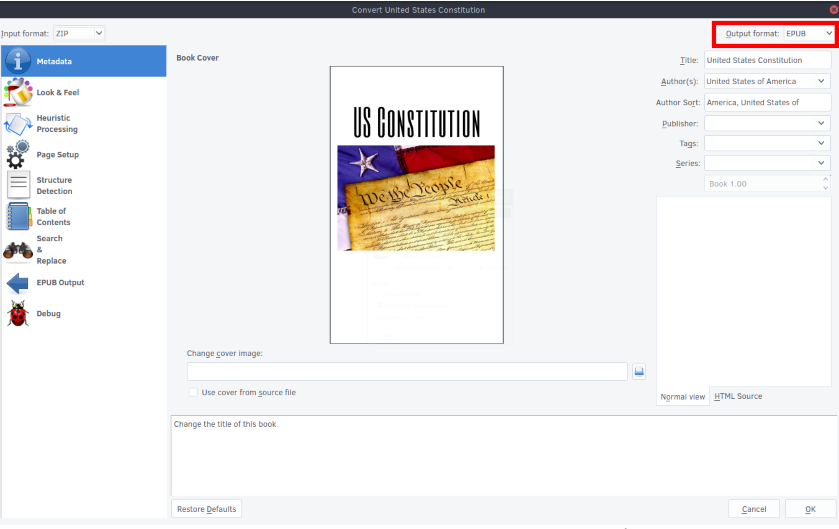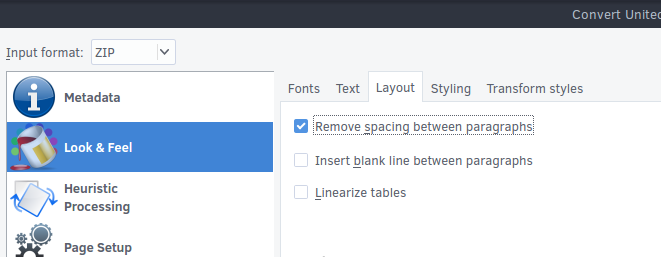Teach you how to use Caliber to create e-books on Linux
Since Amazon started selling e-books many years ago, e-books have grown by leaps and bounds and become more and more popular. The good news is that e-books are very easy to create using free and open source tools, and this beginner's guide tells you how to quickly create an e-book on Linux using the Caliber tool.
Create an e-book on Linux
To create an e-book, you'll probably need two pieces of software: a text processor (of course, I use LibreOffice) and Caliber. Caliber is an excellent e-book reader and e-book library program. You can use it to open ePub files or manage your collection of e-books on Linux. (LCTT translation annotation: LibreOffice is software used to process text on Linux, similar to Office software in Windows)
In addition to these software, you also need to prepare an e-book cover (1410×2250) and your original manuscript.
first step
First, you need to open your manuscript in your text processor program. Caliber can automatically create a book catalog for you. To use this feature, you need to set the heading style of each chapter in your manuscript to "Heading 1". To do this in LibreOffice, just highlight the heading and select "Heading 1" in the paragraph style drop-down box. That’s it.

If you want to have sub-chapters and want them to be added to the table of contents, just set the titles of these sub-chapters to Heading 2. After doing this, save your document as an HTML format file.
Second step
Within the Caliber program, click the "Add Book" button. After the dialog box appears, you can open the HTML format file you just saved and add it to Caliber.

third step
Once the HTML file is added to the Caliber library, select the new file and click the "Edit Metadata" button. Here, you can add the following information: title, author, cover image, description, and other information. When you're done filling it out, click "Ok."

the fourth step
Now click on the "Convert Books" button. In the new window, there will be some options here, but you won't need to use them.

In the selection box at the upper right of the new window, select the epub file format. Caliber also has other options for creating mobi file formats, but I find that things often happen after creating those files that I didn't expect.

the fifth step
In the new dialog box on the left, click "Appearance". Then check "Remove white space between paragraphs".

Next, we will create a content directory. If you don't plan to use a table of contents in your book, you can skip this step. Select the Content Directory tab. Next, click the magic wand icon to the right of "First-level Directory".

In this new window, select "h1" from the drop-down menu under "Match HTML tags." Click "OK" to close this window. If you have subsections, select "h2" under "Second level directory".

Before we start generating the e-book, choose to export the EPUB file. On this new page, select the "Insert Table of Contents" option.

Now all you need to do is click "OK" to start generating the e-book. Unless yours is a large file, the process of generating an e-book is usually completed quickly. At this point, you have created an e-book.
For some special users, such as those who know how to write CSS style files (LCTT translation annotation: CSS files can be used to beautify HTML pages), Caliber gives such users an option to add CSS styles to articles. Just go back to the Appearance section and select the Style tab option. But if you want to create a mobi format file, for some reasons, it cannot accept CSS style files.

Okay, does it feel very easy? I hope this tutorial helped you create ebooks on Linux.
The above is the detailed content of Teach you how to use Caliber to create e-books on Linux. For more information, please follow other related articles on the PHP Chinese website!

Hot AI Tools

Undresser.AI Undress
AI-powered app for creating realistic nude photos

AI Clothes Remover
Online AI tool for removing clothes from photos.

Undress AI Tool
Undress images for free

Clothoff.io
AI clothes remover

AI Hentai Generator
Generate AI Hentai for free.

Hot Article

Hot Tools

Notepad++7.3.1
Easy-to-use and free code editor

SublimeText3 Chinese version
Chinese version, very easy to use

Zend Studio 13.0.1
Powerful PHP integrated development environment

Dreamweaver CS6
Visual web development tools

SublimeText3 Mac version
God-level code editing software (SublimeText3)

Hot Topics
 1378
1378
 52
52
 How to start apache
Apr 13, 2025 pm 01:06 PM
How to start apache
Apr 13, 2025 pm 01:06 PM
The steps to start Apache are as follows: Install Apache (command: sudo apt-get install apache2 or download it from the official website) Start Apache (Linux: sudo systemctl start apache2; Windows: Right-click the "Apache2.4" service and select "Start") Check whether it has been started (Linux: sudo systemctl status apache2; Windows: Check the status of the "Apache2.4" service in the service manager) Enable boot automatically (optional, Linux: sudo systemctl
 What to do if the apache80 port is occupied
Apr 13, 2025 pm 01:24 PM
What to do if the apache80 port is occupied
Apr 13, 2025 pm 01:24 PM
When the Apache 80 port is occupied, the solution is as follows: find out the process that occupies the port and close it. Check the firewall settings to make sure Apache is not blocked. If the above method does not work, please reconfigure Apache to use a different port. Restart the Apache service.
 How to restart the apache server
Apr 13, 2025 pm 01:12 PM
How to restart the apache server
Apr 13, 2025 pm 01:12 PM
To restart the Apache server, follow these steps: Linux/macOS: Run sudo systemctl restart apache2. Windows: Run net stop Apache2.4 and then net start Apache2.4. Run netstat -a | findstr 80 to check the server status.
 How debian readdir integrates with other tools
Apr 13, 2025 am 09:42 AM
How debian readdir integrates with other tools
Apr 13, 2025 am 09:42 AM
The readdir function in the Debian system is a system call used to read directory contents and is often used in C programming. This article will explain how to integrate readdir with other tools to enhance its functionality. Method 1: Combining C language program and pipeline First, write a C program to call the readdir function and output the result: #include#include#include#includeintmain(intargc,char*argv[]){DIR*dir;structdirent*entry;if(argc!=2){
 How to learn Debian syslog
Apr 13, 2025 am 11:51 AM
How to learn Debian syslog
Apr 13, 2025 am 11:51 AM
This guide will guide you to learn how to use Syslog in Debian systems. Syslog is a key service in Linux systems for logging system and application log messages. It helps administrators monitor and analyze system activity to quickly identify and resolve problems. 1. Basic knowledge of Syslog The core functions of Syslog include: centrally collecting and managing log messages; supporting multiple log output formats and target locations (such as files or networks); providing real-time log viewing and filtering functions. 2. Install and configure Syslog (using Rsyslog) The Debian system uses Rsyslog by default. You can install it with the following command: sudoaptupdatesud
 How to solve the problem that apache cannot be started
Apr 13, 2025 pm 01:21 PM
How to solve the problem that apache cannot be started
Apr 13, 2025 pm 01:21 PM
Apache cannot start because the following reasons may be: Configuration file syntax error. Conflict with other application ports. Permissions issue. Out of memory. Process deadlock. Daemon failure. SELinux permissions issues. Firewall problem. Software conflict.
 Does the internet run on Linux?
Apr 14, 2025 am 12:03 AM
Does the internet run on Linux?
Apr 14, 2025 am 12:03 AM
The Internet does not rely on a single operating system, but Linux plays an important role in it. Linux is widely used in servers and network devices and is popular for its stability, security and scalability.
 How to fix apache vulnerability
Apr 13, 2025 pm 12:54 PM
How to fix apache vulnerability
Apr 13, 2025 pm 12:54 PM
Steps to fix the Apache vulnerability include: 1. Determine the affected version; 2. Apply security updates; 3. Restart Apache; 4. Verify the fix; 5. Enable security features.




